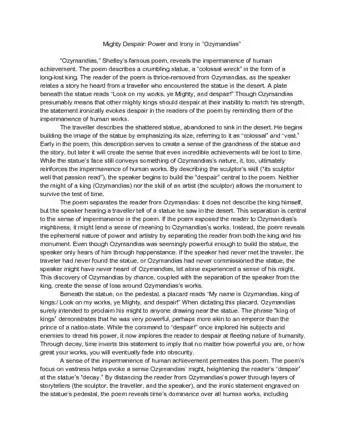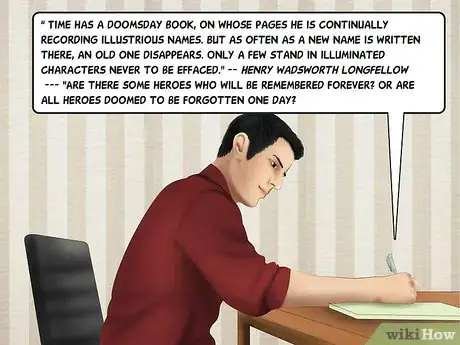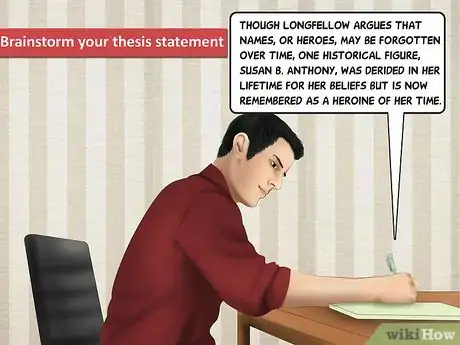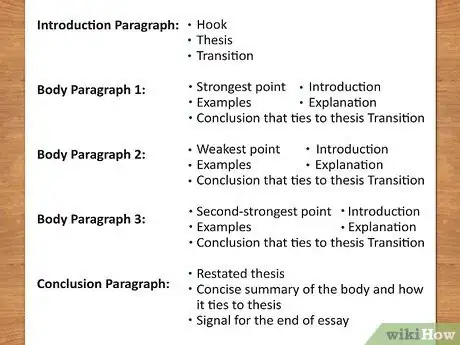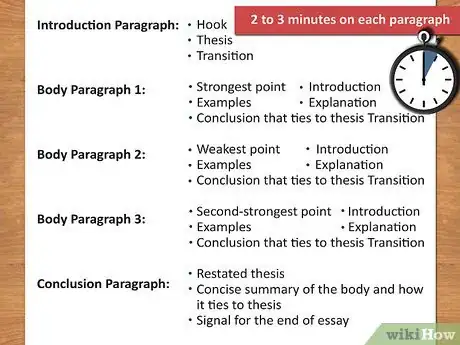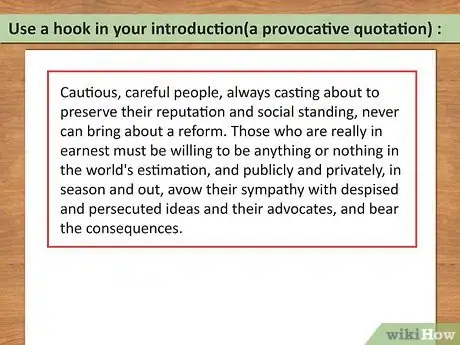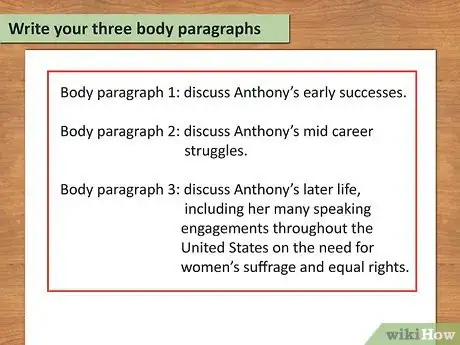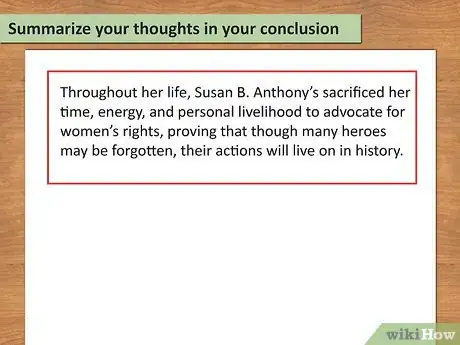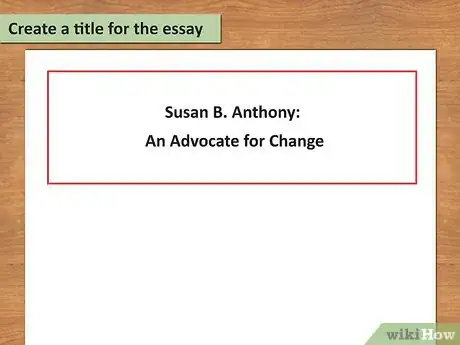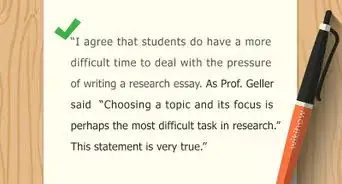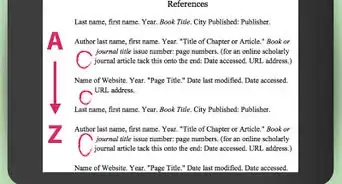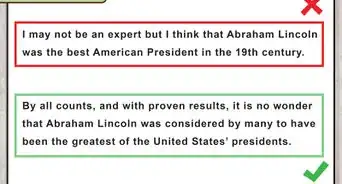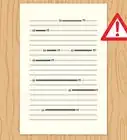This article was co-authored by Arash Fayz. Arash Fayz is the Co-Founder and Executive Director of LA Tutors 123, an academic consulting and private tutoring company based in Los Angeles, California. Arash has over 10 years of educational consulting experience, managing the tutoring of students of all ages, abilities, and backgrounds to score higher on standardized tests and gain admission to their target schools. He has a BA in Applied Mathematics and Computer Science from the University of California, Los Angeles.
There are 13 references cited in this article, which can be found at the bottom of the page.
wikiHow marks an article as reader-approved once it receives enough positive feedback. This article has 23 testimonials from our readers, earning it our reader-approved status.
This article has been viewed 584,103 times.
If you’re taking your SATs this year, you may be preparing to write a solid essay within the 30 minute time limit. Or you might be trying to improve your writing speed to complete essay exams faster and more efficiently. Writing a five paragraph essay in under 30 minutes can seem daunting, but with the right planning and time management, it is certainly achievable.
Steps
Sample Essays
Planning the Essay
-
1
-
2Study the essay question. The essay will likely be directed by a question or a prompt, like a quote, with a question. It’s important that you read the question carefully and understand what it is asking of you.
- For example, you may get a prompt in the form of quotation: “Time has a doomsday book, on whose pages he is continually recording illustrious names. But as often as a new name is written there, an old one disappears. Only a few stand in illuminated characters never to be effaced.” Henry Wadsworth Longfellow[3]
- You may then receive a question attached to the prompt: “Are there some heroes who will be remembered forever? Or are all heroes doomed to be forgotten one day?" Plan your response, and then write an essay to explain your views on this issue. Be sure to support your position with specific points and examples. You may use personal examples or examples from your reading, observations, or, knowledge of subjects such as history, literature, science.[4]
Advertisement -
3Brainstorm your thesis statement. A thesis statement will convey to your reader the points or arguments you are going to make in your paper. It acts a road map for your paper and should answer the question, “What is this paper about?” It should take a stand and announce your position towards the topic.[5]
- For example, you may brainstorm the Longfellow quote/question by thinking of personal examples of heroes who are remembered or forgotten, such as family members, friends, teachers, or peers who have acted as heroes to you or to others. Or you may focus on a historical figure who seems to be a forgotten hero or a decorated hero.
- This essay question is asking for two sides of the discussion, the forgotten hero and the remembered hero. Your thesis should discuss both sides and choose one side to argue for or against.
- You may choose to spotlight a historical figure who encountered opposition and challenges in her life, such as the suffragette Susan B. Anthony. Anthony worked tirelessly for decades to get the government to recognize women’s right to vote, and was often derided by the government and by individuals within her own organization. She is a good example of a hero who was not recognized as a trailblazer until late in her life, though she is now remembered as a heroine in history. Try to refer back to the quotation in the essay prompt in your thesis, if possible, to show you have read the entire question.
- A possible thesis statement could be: “Though Longfellow argues that names, or heroes, may be forgotten over time, one historical figure, Susan B. Anthony, was derided in her lifetime for her beliefs but is now remembered as a heroine of her time.”
-
4Create an outline. Make a rough outline of your five paragraph essay:
- Introduction: Your beginning paragraph should contain an engaging first sentence and your thesis statement. Some writers find it easier to write create a temporary introduction and revise it once they are finished with the essay. This will ensure the introduction is cohesive with the rest of the essay.
- Body paragraph 1-3: Each paragraph should discuss one major point of your thesis, with at least one supporting example.[6]
- Conclusion: This paragraph should summarize your main argument and restate your thesis. You may also want to include last thoughts around the essay question.
Writing the Essay
-
1Take 15 minutes to write the essay. Now that you have your thesis statement and your outline, focus on composing content for each part of the essay.[7]
- Try to spend two to three minutes on each body paragraph. Then, take three minutes on your conclusion paragraph and go back to your introduction. Spend the last three minutes revising your introduction so it matches the tone and perspective of the rest of your essay.
-
2Use a hook in your introduction. There are several possible hooks you can use in your essay to draw your reader in.[8]
- An interesting or surprising example: This could be a personal experience or a key moment in the life of the historical figure you are discussing in your essay. For example, you may discuss Anthony’s childhood as a Quaker and her later adoption of more casual dress and growing interest in social reform at the age of 26.[9]
- A provocative quotation: This could be from a source you used for your essay or one that feels relevant to your topic. For example, you may use a well known quote from Anthony, such as: “Cautious, careful people, always casting about to preserve their reputation and social standing, never can bring about a reform. Those who are really in earnest must be willing to be anything or nothing in the world's estimation, and publicly and privately, in season and out, avow their sympathy with despised and persecuted ideas and their advocates, and bear the consequences.”[10]
- A vivid anecdote: An anecdote is a very short story that carries moral or symbolic weight. Think of an anecdote that might be a poetic or powerful way to start your essay.
- A thought provoking question: create a question that will get your reader thinking and engaged in your topic. For example: “Did you ever wonder how women received the right to vote in the United States?”
-
3Write your three body paragraphs. Focus on fleshing out each paragraph with at least one example of your main point. Sign-post each paragraph by beginning with a strong argumentative point that links to a supporting example of your main point. If you use an essay on Susan B. Anthony as an example:[11]
- Body paragraph 1: You may start by discussing Anthony’s early successes. Look at the establishment of the Women’s Loyal National League in 1863 by Anthony and Stanton. As the first national women’s political organization in the United States, it had a membership of 5000 and provided a platform for women to speak out on issues like slavery and women’s right to vote.[12]
- Body paragraph 2: You may discuss Anthony’s mid career struggles. Look at the split in the women’s movement in May 1869, with the establishment of the National Woman’s Suffrage Association (NWSA) by Anthony and Stanton, and the rival American Woman Suffrage Association (AWSA). Note how after the Civil War, Anthony devoted her time and life to the suffrage movement, assuming leadership of the NWSA in 1890 and continuing to advocate for women’s rights. Anthony also remained unmarried, which gave her an advantage under the law, as married women at the time were not permitted to sign official documents and had to defer to their husbands.[13]
- Body paragraph 3: You may discuss Anthony’s later life, including her many speaking engagements throughout the United States on the need for women’s suffrage and equal rights. Though Anthony died in 1906, and did not live to see the passing of the Nineteenth Amendment of the Constitution, affording women the right to vote in the United States in 1920, her forty years of tireless work paved the way for the legal precedent and gave women a strong sense of empowerment and equality.[14]
-
4Summarize your thoughts in your conclusion. Make your conclusion clear and to the point. Avoid introducing new ideas or arguments in your conclusion. Instead, restate your thesis and your main points.
- For example, you may restate your thesis: “Throughout her life, Susan B. Anthony’s sacrificed her time, energy, and personal livelihood to advocate for women’s rights, proving that though many heroes may be forgotten, their actions will live on in history.”
Editing the Essay
-
1Use the last five minutes to proofread your essay. Look for any spelling, punctuation, or grammatical errors. You may want to read your essay backwards to check for any spelling issues, as you will only be focusing on the words themselves, rather than the meaning of the sentences.
-
2Create a title for the essay. It can be easier to create a title for your essay once you have finished it. You could use a quotation from the essay, a phrase or term you refer back to often in the essay, or a summary of your main point.
- For example, an essay on Susan B. Anthony could have the title: “An Unsung Heroine” or “Susan B. Anthony: An Advocate for Change”.
Community Q&A
-
QuestionHow can I write an essay about Ender's Game?
 Community AnswerIntroduce the characters and set up the story with any necessary background information. Then explain what happens in the story and what you think the author is trying to say. Is there a moral to the story? What is the point?
Community AnswerIntroduce the characters and set up the story with any necessary background information. Then explain what happens in the story and what you think the author is trying to say. Is there a moral to the story? What is the point? -
QuestionHow do I come up with a good hook for an essay?
 Community AnswerUse an anecdote, a quote, or a fact/statistic. Try to avoid using a question.
Community AnswerUse an anecdote, a quote, or a fact/statistic. Try to avoid using a question. -
QuestionWhat would be a good hook for an essay about cells?
 Community Answer"Cells, the basic block of all living organisms, the little guys that make sure everything runs smoothly in your body and keep you alive."
Community Answer"Cells, the basic block of all living organisms, the little guys that make sure everything runs smoothly in your body and keep you alive."
References
- ↑ Arash Fayz. Test Prep Tutor. Expert Interview. 1 November 2019.
- ↑ https://libguides.newcastle.edu.au/essay_planning/essay-planning
- ↑ https://resources.warburg.sas.ac.uk/pdf/emh823b2778298.pdf
- ↑ https://www.hunter.cuny.edu/rwc/handouts/the-writing-process-1/invention/Writing-a-Response-or-Reaction-Paper
- ↑ https://writingcenter.unc.edu/tips-and-tools/thesis-statements/
- ↑ Arash Fayz. Test Prep Tutor. Expert Interview. 1 November 2019.
- ↑ https://kidshealth.org/en/teens/test-terror.html
- ↑ https://writingcenter.unc.edu/tips-and-tools/introductions/
- ↑ https://writingcenter.unc.edu/tips-and-tools/should-i-use-i/
- ↑ https://www.rochester.edu/sba/
- ↑ https://www.jscc.edu/academics/programs/writing-center/writing-resources/five-paragraph-essay.html
- ↑ https://repository.library.georgetown.edu/bitstream/handle/10822/553350/laCossJoanHarkin.pdf
- ↑ https://www.womenshistory.org/education-resources/biographies/susan-b-anthony
- ↑ https://www.britannica.com/biography/Susan-B-Anthony
About This Article
In order to successfully write an essay in under 30 minutes, you need to plan it out and work efficiently. Take a good 10 minutes to plan out the essay and come up with a thesis statement that will convey your argument and help guide your essay. It may seem like a large chunk of your time, but it will save you from having to rewrite or restructure your essay later on. Then, take 15 minutes to write your introductory paragraph, body paragraphs, and conclusion. Use the last 5 minutes to proofread your essay and look for spelling, punctuation, or grammatical errors. Don’t worry about coming up with a title until you’re finished. It will be much easier then. For tips about how to edit an essay you write in under 30 minutes, keep reading!

